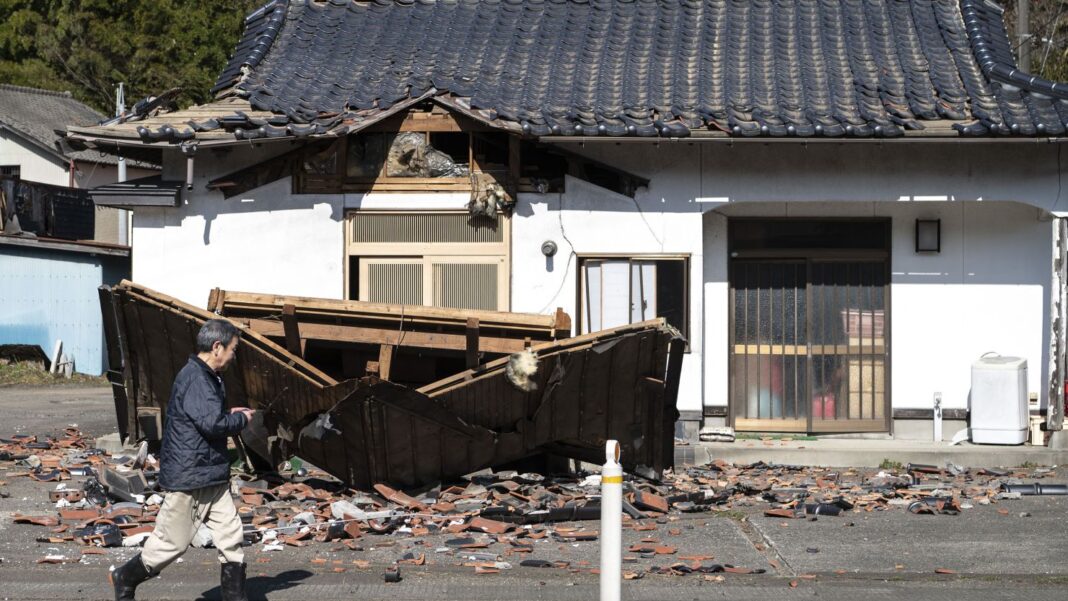Japan earthquake: Japan’s west coast is in the grip of a seismic crisis as a rapid series of powerful earthquakes, numbering around 20 in total, struck the Noto region on the western side of Honshu, the country’s main island. The Japan Meteorological Agency (JMA) recorded the first quake at 5.7 magnitude at 4:06 p.m. local time, setting off a chain reaction that included a major 7.6-magnitude quake just four minutes later. Subsequent tremors ranged in magnitude, creating a state of emergency in the affected areas.
Tsunami Warnings and Urgent Evacuations
The series of earthquakes triggered tsunami warnings, urging residents to seek higher ground immediately. The first tsunami waves, measuring around four feet high, reached Ishikawa prefecture’s Wajima port about an hour after the initial quakes. Authorities warned of the potential for larger tsunamis, up to 16 feet high, to follow in Ishikawa. Presenters on national broadcaster NHK urged people to abandon belongings and move swiftly to elevated areas.
The Hawaii-based Pacific Tsunami Warning Center echoed the urgency, stating, “Hazardous tsunami waves from this earthquake are possible within 300 km of the epicenter along the coasts of Japan.” The Japan Meteorological Agency warned that waves could reach up to five meters in height.
Nuclear Plant Safety and Infrastructure Damage
Power companies overseeing nuclear plants in the affected region reported checking for irregularities but assured the public of the safety of the plants. The national government spokesperson, Hayashi Yoshimasa, confirmed, “It has been confirmed that there are no abnormalities at Shika nuclear power plant [in Ishikawa] and other stations as of now.”
However, reports indicate visible damage from the earthquakes. NHK aired footage showing buildings collapsing in Ishikawa, and there were reports of damage across the region. Hokuriku Electric Power reported over 36,000 households losing electricity in Ishikawa and Toyama prefectures. Bullet trains were halted, sections of the highway were closed, and burst water pipes added to the challenges faced by residents.
Immediate Response and Ongoing Threat
The Japanese government swiftly set up a special emergency center to gather information on the earthquakes and tsunami, relaying critical updates to residents to ensure their safety. Prime Minister Fumio Kishida emphasized the need for immediate evacuation in affected areas.
The Meteorological Agency held a nationally broadcast news conference, warning of the potential for more major quakes in the area over the next week, particularly in the next two or three days. Tsunami warnings extended to Japan’s northernmost main island of Hokkaido, as well as parts of North Korea and Russia. In South Korea, the weather agency urged residents in some eastern coastal towns to monitor sea levels for possible changes.
Reflections on Past Tragedies
The current seismic activity brings back haunting memories of the devastating earthquake and tsunami that struck northeast Japan on March 11, 2011. The 2011 disaster left a vast stretch of the country’s coastline in ruins and triggered nuclear reactor meltdowns in Fukushima, underscoring the persistent threat posed by natural disasters in the region.
As the affected areas grapple with the immediate aftermath of the earthquakes, communities are on high alert, and emergency response efforts are underway to mitigate the impact of potential tsunamis and aftershocks. The resilience of the Japanese people, combined with swift and coordinated response measures, will play a crucial role in overcoming the challenges posed by this seismic crisis.
Japan earthquake:
Read here: “Ring in 2024: Times Square Ball Drop and New Year’s Eve Spectacle Highlights”



